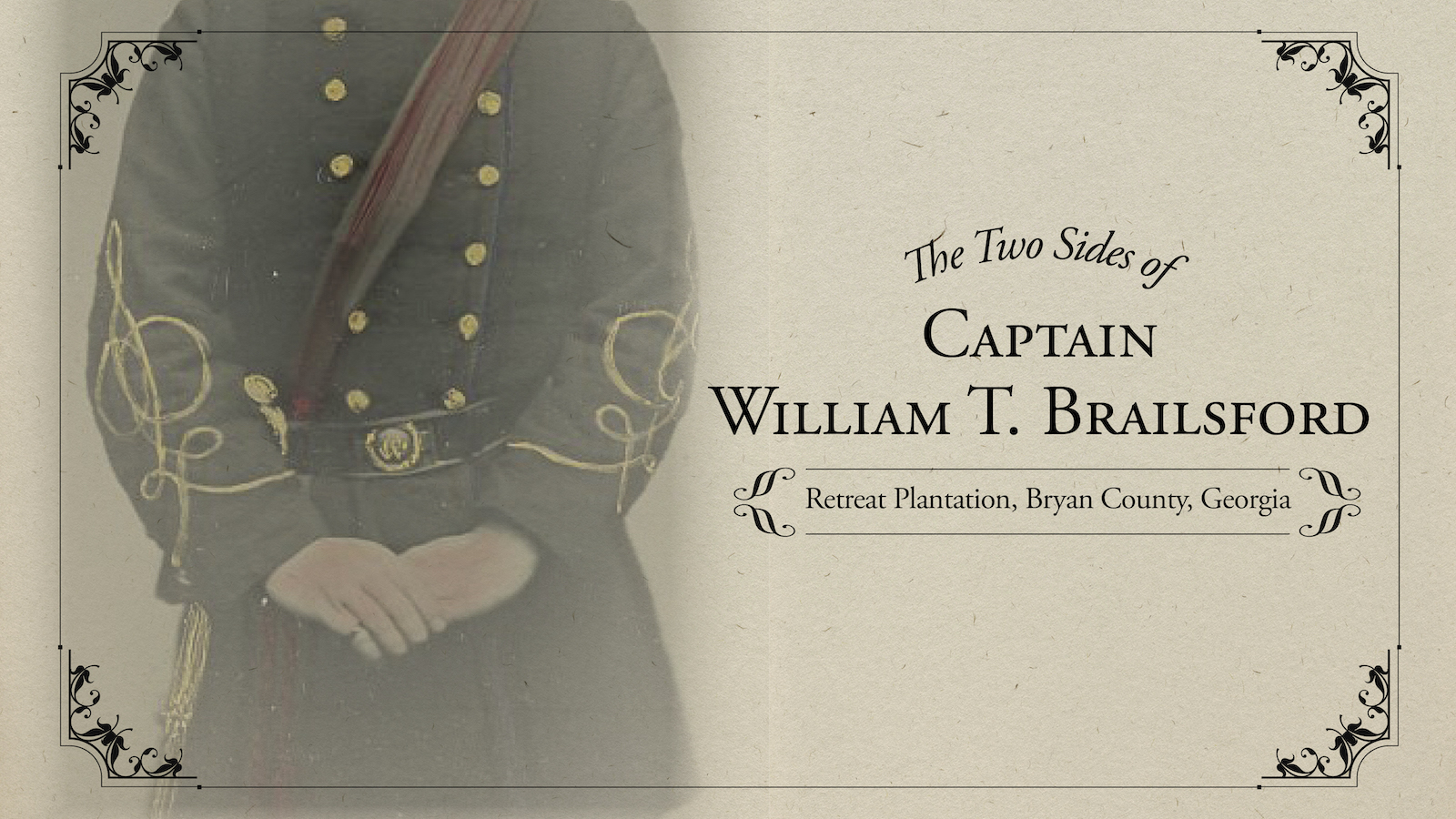
The Two Sides of Captain William T. Brailsford
Retreat Plantation, Bryan County, Georgia
WORDS BY CHRISTY SHERMAN
2023 ANNUAL ISSUE

Often when doing historical or genealogical research, a person’s obituary can give you valuable clues and information. Still, frequently, it is limited to a name, birth date, death date, family members, place of burial, etc. It is less common to find a detailed description of the person’s personality and character traits. So I became intrigued when I read the obituary of Captain William Brailsford (1826-1887) of Retreat plantation in Bryan County. My research came about in part because I live on a portion of the 200-acre tract of his former cotton plantation. Retreat was located on the lower end of Bryan Neck, bordered to the west by Fancy Hall plantation, overlooking the St. Catherines Sound.
When William died on June 20, 1887, the Savannah Morning News carried the following in his obituary: He was probably the last of his class in Georgia. Money with him was made only to spend, not in his own enjoyment, but in contributing to the enjoyment of others. Ready at all times to serve a friend, even at the risk of his life, he was often identified with affairs of honor in the days when men were called upon by public sentiment to recognize the code duello.
It is unknown who wrote the obituary, but this glowing tribute does a good job of “washing away the sins” of perhaps one of Bryan Neck’s most controversial figures…
William Brailsford was born into two wealthy planter families of McIntosh County. He was the son of Col. Daniel Heyward Brailsford and grandson of William Brailsford of Broadfield Plantation (now Hofwyl-Broadfield). His mother, Jane Martin Leake Spalding was the daughter of Thomas Spalding of Sapelo, a prominent planter, agriculturist and politician.
When William was just seven years old, his father was murdered in McIntosh County by his former overseer, John Forbes, ostensibly in response to the termination of his employment. The Savannah Georgian reported on August 27, 1833: “On the morning of August 22, while the deceased was on the road superintending the public work, Forbes rode up, and after some violent abuse, which was unprovoked, made an assault on the deceased with the muzzle of a double-barreled gun, inflicting two severe wounds on the lower jaw, and but for the interposition of armed men, one of whom was a commissioner, it is supposed (Forbes) would then have carried into effect his vengeful purpose.
On the evening of the same day, and nearly on the same spot, while the deceased was giving orders for the next day, Forbes again rode up, and dismounting from his horse, shot the deceased with a double barreled gun, the contents of which entered a little below the groin and instantly deprived him of life. Thus perished Col. D. H. Brailsford, in the prime of his life, aged 36 years.” In Children of Pride, editor Robert Manson notes that the motive for the murder was “allegedly in response to Brailsford’s attentions to Forbes’s wife.” Three months after the incident, Forbes was convicted of murder and then executed by hanging at Darien on December 27, 1833.
On the 1850 census, twenty-three year old William was listed as a planter, having inherited his father’s Retreat Plantation in Bryan County and Sutherland’s Bluff in McIntosh County. This decade would prove to be very profitable for cultivating rice and cotton in coastal Georgia. He and his friends had the time and money necessary to indulge in outdoor pursuits, horse betting, and revelry, frequently ending in disputes with others. One of his close associates was Charles Augustus Lafayette Lamar, who was a fellow member of the exclusive Savannah Jockey Club with Brailsford. Lamar was a Savannah-born businessman who, in 1858, successfully carried out a scheme to convert the luxury schooner, The Wanderer, to a cargo ship for the purpose of smuggling enslaved people to Georgia from Africa. Though the Atlantic slave trade had been prohibited since 1808, Lamar and his associates were successful in kidnapping and transporting 487 people, of whom 78 perished on the journey.
With the onset of the Civil War, life for the wealthy planters and their families was about to change. William enlisted in the Confederacy in May of 1861, with the Savannah Mounted Rifles as first lieutenant, and succeeded Lamar as captain in September. The Mounted Rifles became known as Brailsford’s Company and Brailsford’s Lamar Rangers, and later the 1st Battalion Georgia Cavalry and ultimately the 5th Georgia Cavalry, Company H.
In November 1862, some of Captain Brailsford’s “sins” were noted in newspapers far beyond Georgia, including the front page of the Chicago Tribune. The papers reported that Brailsford’s Sutherland’s Bluff plantation in McIntosh had been destroyed by fire by a newly formed Black regiment of the Union Army. This act was in retaliation for Brailford’s mistreatment of his enslaved people and for a recent campaign he led for the Confederate Army to recapture a large number of enslaved people who had either run away or had been taken to the Georgia Islands by Union forces. When Union officers denied Brailsford’s request to return Black fugitives to the local planters, he and a group of thirty armed men took a boat to St. Catherines Island, killed two runaways, and captured four others.
Georgia’s Black soldiers did not forget the attacks at St. Catherines Island as they raided Sapelo River plantations. Brailsford’s home at Sutherland’s Bluff became a target since it was a Confederate headquarters and picket station due to its ideal vantage point for observing Union ships in the Sapelo Sound. The troops who burned the home included some of Brailsford’s formerly enslaved men from Sutherland’s Bluff, who had been given “full consultation” by Union commanders to destroy the place of their hot-tempered master. After the attack, morale amongst the troops was high. One man said he felt like he had “grown three inches,” while another, named Sam Miller, who had recently been on the wrong side of Brailsford’s ire, said, “I feel a heap more of a man.”
Two years after the raid on his Sutherland’s Bluff plantation, Brailsford was captured by Union troops near Murfreesboro, Tennessee, on September 6, 1864. He was taken prisoner to the Union camp at Johnson’s Island, Ohio. Several weeks after his capture, one of his Bryan County neighbors tried to offer assistance. Thomas Clay Arnold, son of Richard James Arnold of White Hall plantation, wrote to his father: “If you could send him a little money and some comforts, I would be glad as he had been kind to me.” Before the war, Brailsford had been one of the wealthiest cotton planters on the Georgia coast, like the elder Arnold, yet they were quite the opposite in their behavior. It is not known if any help was provided by Richard Arnold, but we do know that Brailsford was not released until May 30, 1865. After the war, he settled in Bryan County at Retreat, where he lived out the rest of his days with his natural daughter, Catherine, a mixed-race servant to whom he bequeathed all of his property.
Brailsford died at Retreat on June 29, 1887, and is buried in the family cemetery.





